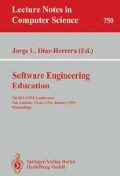Abstract
The incorporation of software engineering into an existing university computer science curriculum involves major cultural and content changes. Considerable persistence is required (note the golden arches), yet even the best laid plans do not always suffice (note quotation from famous poem by Burns). This is particularly true for those departments which have a strong mathematics emphasis — a common phenomenon in many comprehensive universities (M.S. granting) today. Despite the major challenges involved in such change, the rewards are many. The beneficiaries include: current students, graduates, employers, computer science faculty, the university, and society.
Preview
Unable to display preview. Download preview PDF.
References
ACM, Curriculum '91, ACM Press, New York, 1991.
Boehm, B., Software Engineering Economics, McGraw-Hill, 1986.
Brooks, B., “No Silver Bullet: Essence and Accidents of Software Engineering”, Computer, IEEE, April, 1987, pp. 10–19.
Bruegge, B. “Teaching an Industry-Oriented Software Engineering Course”, Software Engineering Education, SEI Conference, Springer/Verlag, October, 1992.
Burns, R., “To A Mouse, on Turning Her up in her Nest with a Plough, November, 1785”, The Poems and Songs of Robert Burns, p. 125.
Computing Sciences Accreditation Board, “Criteria for Accrediting Programs in Computer Science in the United States”, June, 1992.
DeMarco, T., Controlling Software Projects. Yourdon Press, 1982.
Frailey, D. “CS Employers: What They Want,” Syllabus on Computer Science, Syllabus Press, Sunnyvale, CA, Spring, 1992, pp. 8–9.
Gilb, T., Principles of Software Management. McGraw-Hill, 1989.
Hoare, C.A.R., “The Engineering of Software: A Startling Contradiction”, Computer Bulletin, December, 1975.
Johnson, D. W., R.T. Johnson, and K. A. Smith, Cooperative Learning: Increasing College Faculty Instructional Productivity. ASHE-ERIC Higher Education Report No. 4, 1991.
Kaufman, R., Identifying and Solving Problems. Third Edition, University Associates, San Diego, CA, 1982.
Koen, B., Definition of the Engineering Method. American Society for Engineering Education, Washington, D.C., 1985.
Koen, B., “The Engineering Method and the State-of-the-Art”, Engineering Education, April, 1986, pp. 570–674.
Modesitt, K., “Computer-based Learning, Expert Systems, and Software Engineering: Advanced Tools for Engineering Education Now and in 2001”, International Journal of Applied Engineering Education, Tempus Publications, vol. 7, No. 6, 1991, pp. 452–455. Also presented at the Frontiers in Education Conference, American Society for Engineering Education, Vienna, 1990, and at Bond University, Gold Coast, Queensland, Australia, 1990.
Modesitt, K., Computer Science in the Real World: Expert Systems, Software Engineering, and Computer-based Learning: Engineering of Complex Reliable Software Systems, and How Computers Can Help People Learn to Build Them. Two-week series of invited lectures given to the Department of Computer Science and Engineering, University of Science and Technology, Beijing, People's Republic of China, June, 1991.
Modesitt, K., “Computer Based Learning: Important Problems, Creative People, and Powerful Affordable Tools,” Journal of Computer-Based Instruction, Vol. 9, May, 1983, pp. 26–33. IEEE International Conference on Consumer Electronics, June, 1983, pp. 206–207. Also Association of Educational Data Systems (AEDS) National Conference, 1983, pp. 213–217; National Society for Performance and Instruction (NSPI) National Conference, 1983.
Modesitt, K. “Software Engineering Training for TI Middle Management,” Invited Presentation for ACM National Conference, 1980.
Moore F. and P. Purvis, “Meeting the Training Need of Practicing Software Engineers with the Defense System Electronics Group,” Texas Instruments Technical Journal, May–June, 1989, pp. 61–67.
NTU, “NTU Celebrating Five Years,” NTU UPLINK, National Technological University, Vol. 5., Num. 4, April, 1990.
Pressman, R., Software Engineering: A Practitioner's Approach, Third Edition, McGraw-Hill, 1992.
SACS, Criteria for Accreditation: Commission on Colleges. Southern Association of Colleges and Schools, 1988.
Shapiro, M., “Software is a product ... NOT!” IEEE Computer, September, 1992, p. 128.
Taguchi, G. and M.S. Phadke, “Quality Engineering Through Design Optimization,” Proceedings of the Globecom 84 Meeting, IEEE Communication Society, 1984, pp. 1106–1113.
Technology Reinvestment Project, “Program Information Package for Defense Technology Conversion, Reinvestment, and Transition Assistance, Arlington, VA March 10, 1993.
Yourdon, E., Tools and Techniques of Modern Software Engineering. Yourdon Press, 1987.
Author information
Authors and Affiliations
Editor information
Rights and permissions
Copyright information
© 1993 Springer-Verlag Berlin Heidelberg
About this paper
Cite this paper
Modesitt, K.L. (1993). When the golden arches gang aft agley: Incorporating software engineering into computer science. In: Díaz-Herrera, J.L. (eds) Software Engineering Education. CSEE 1994. Lecture Notes in Computer Science, vol 750. Springer, Berlin, Heidelberg. https://doi.org/10.1007/BFb0017606
Download citation
DOI: https://doi.org/10.1007/BFb0017606
Published:
Publisher Name: Springer, Berlin, Heidelberg
Print ISBN: 978-3-540-57461-3
Online ISBN: 978-3-540-48191-1
eBook Packages: Springer Book Archive

